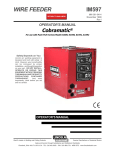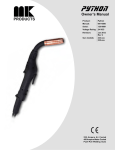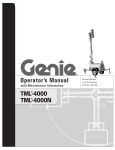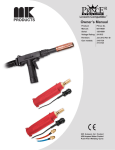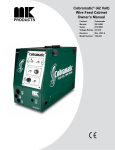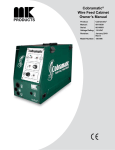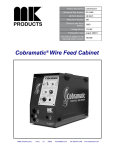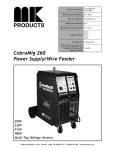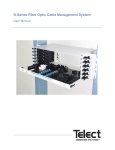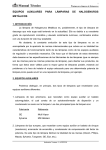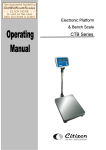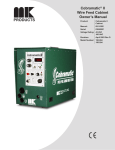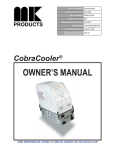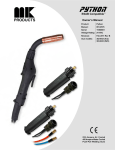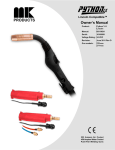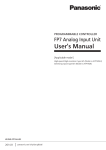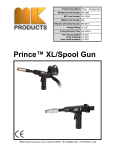Download Cobramatic Manual
Transcript
Product Description M.K. Manual Part Number M.K. Form Number NWSA Form Number Effective with Serial Number Voltage Ratings Printing/Rev. Date This manual applies to the following Cabinet Model Numbers Cobramatic Cabinet 091-0246 CWFIA 550 32135 F92 115 VAC December 1999 C 150-003 Cobramatic® Wire Feed Cabinet 16882 ARMSTRONG AVE., IRVINE, CALIFORNIA 92606 TEL (949)863-1234 FAX (949)474-1428 SAFETY CONSIDERATIONS ELECTRIC ARC WELDING EQUIPMENT CAUTION : READ BEFORE ATTEMPTING INSTALLATION, OPERATION OR MAINTENANCE OF THIS EQUIPMENT 1-1 INTRODUCTION This equipment is intended for ultimate application by commercial/industrial users and for operation by persons trained and experienced in the use and maintenance of welding equipment. Operation should not be undertaken without adequate training in the use of such equipment. Training is available from many public and private schools or similar facilities. Safe practices in the installation, operation and maintenance of this equipment requires proper training in the art, a careful study of the information provided with the equipment, and the use of common sense. Rules for safe use are generally provided by suppliers of welding power sources, compressed gas suppliers, and electrode suppliers. Careful compliance with these rules will promote safe use of this equipment. The following Safety Rules cover some of the more generally found situations. READ THEM CAREFULLY. In case of any doubt, obtain qualified help before proceeding. 1-2 GENERAL PRECAUTIONS A. Burn Prevention ELECTRIC ARC WELDING PRODUCES HIGH INTENSITY HEAT AND ULTRAVIOLET RADIANT ENERGY WHICH MAY CAUSE SERIOUS AND PERMANENT EYE DAMAGE AND WHICH MAY DAMAGE ANY EXPOSED SKIN AREAS. Wear helmet with safety goggles or glasses with side shields underneath, appropriate filter lenses or plates (protected by clear cover glass). This is a must for welding or cutting (and chipping) to protect the eyes from radiant energy and flying metal. Replace cover glass when broken, pitted, or spattered. Medical first aid and eye treatment. First aid facilities and a qualified first aid person should be available for each shift unless medical facilities are close by for immediate treatment of flash burns of the eyes and skin burns. Wear protective clothing - leather (or asbestos) gauntlet gloves, hat, and high safety-toe shoes. Button shirt collar and pocket flaps, and wear cuffless trousers to avoid entry of sparks and slag. Avoid oily or greasy clothing. A spark may ignite them. Flammable hair preparations should not be used by persons intending to weld or cut. Hot metal such as electrode stubs and work pieces should never be handled without gloves. Ear plugs should be worn when working on overhead or in a confined space. A hard hat should be worn when others work overhead. B. Toxic Fume Prevention WARNING: The use of this product may result in exposure to chemicals known to the State of California to cause cancer and birth defects or other reproductive harm. Adequate ventilation. Severe discomfort, illness or death can result from fumes, vapors, heat, or oxygen enrichment or depletion that welding (or cutting) may produce. Prevent them with adequate ventilation. NEVER ventilate with oxygen. Lead-, cadmium-, zinc-, mercury-, beryllium-bearing and similar materials, when welded or cut, may produce harmful concentrations of toxic fumes. Adequate local exhaust ventilation must be used, or each person in the area, as well as the operator, must wear an air-supplied respirator. For beryllium, both must be used. Metals coated with or containing materials that emit toxic fumes should not be heated unless coating is removed form the work surface, the area is well ventilated, or the operator wears an air-supplied respirator. Work in a confined space only while it is being ventilated and, if necessary, while wearing an air-supplied respirator. Gas leaks in a confined space should be avoided. Leaked gas in large quantities can change oxygen concentration dangerously. Do not bring gas cylinders into a confined space. Leaving confined space, shut OFF gas supply at source to prevent possible accumulation of gases in the space if downstream valves have been accidentally opened or left open. Check to be sure that the space is safe before reentering it. Vapors from chlorinated solvents can be decomposed by the heat of the arc (or flame) to form PHOSGENE, a highly toxic gas, and other lung and eye irritating products. The ultraviolet (radiant) energy of the arc can also decompose trichloroethylene and perchloroethylene vapors to form phosgene. DO NOT WELD or cut where solvent vapors can be drawn into the welding or cutting atmosphere or where the radiant energy can penetrate to atmospheres containing even minute amounts of trichloroethylene or perchloroethylene. C. Fire and Explosion Prevention Causes of fire and explosion are: combustibles reached by the arc, flame, flying sparks, hot slag, or heated material, misuse of compressed gases and cylinders, and short circuits. BE AWARE THAT flying sparks or falling slag can pass through cracks, along pipes, through windows or doors, and through wall or floor openings, out of sight of the goggled operator. Sparks can fly many feet. To prevent fires and explosion: Keep equipment clean and operable, free of oil, grease, and (in electrical parts) of metallic particles that can cause short circuits. If combustibles are in area, do NOT weld or cut. Move the work if practicable, to an area free of combustibles. Avoid paint spray rooms, dip tanks, storage areas, ventilators. If the work cannot be moved, move combustibles at least 35 feet away, out of reach of sparks and heat; or protect against ignition with suitable and snug-fitting, fire-resistant covers or shields. Walls touching combustibles on opposite sides should not be welded on (or cut). Walls, ceilings, and floor near work should be protected by heat-resistant covers or shields. Fire watcher must be standing by with suitable fire extinguishing equipment during and for some time after welding or cutting if: 1. Appreciable combustibles (including building construction) are within 35 feet. 2. Appreciable combustibles are further than 35 feet, but can be ignited by sparks. 3. Openings (concealed or visible) in floors or walls within 35 feet may expose combustibles to sparks. 4. Combustibles adjacent to walls, ceilings, roofs, or metal partitions can be ignited by radiant or conducted heat. Hot work permit should be obtained before operation to ensure supervisor’s approval that adequate precautions have been taken. After work is done, check that area is free of sparks, glowing embers, and flames. An empty container that held combustibles, or that can produce flammable or toxic vapors when heated, must never be welded on or cut, unless container has first been cleaned in accordance with industry standards. This includes: a thorough steam or caustic cleaning (or a solvent of water washing, depending on the combustible’s solubility), followed by purging and inerting with nitrogen or carbon dioxide, and using protective equipment. Water-filling just below working level may substitute for inerting. A container with unknown contents should be cleaned (see paragraph above). Do NOT depend on sense of smell or sight to determine if it is safe to weld or cut. Hollow castings or containers must be vented before welding or cutting. They can explode. Explosive atmospheres. NEVER weld or cut where the air may contain flammable dust, gas, or liquid vapors (such as gasoline). D. Compressed Gas Equipment The safe handling of compressed gas equipment is detailed in numerous industry publications. The following general rules cover many of the most common situations. 1. Pressure Regulators Regulator relief valve is designed to protect only the regulator from overpressure; it is not intended to protect any downstream equipment. Provide such protection with one or more relief devices. Never connect a regulator to a cylinder containing gas other than that for which the regulator was designed. Remove faulty regulator from service immediately for repair (first close cylinder valve). The following symptoms indicate a faulty regulator: Leaks - if gas leaks externally. Excessive Creep - if delivery pressure continues to rise with downstream valve closed. Faulty Gauge - if gauge pointer does not move off stop pin when pressurized, nor returns to stop pin after pressure release. Repair. Do NOT attempt repair. Send faulty regulators for repair to manufacturer’s designated repair center, where special techniques and tools are used by trained personnel. 2. Cylinders Cylinders must be handled carefully to prevent leaks and damage to their walls, valves, or safety devices: Avoid electrical circuit contact with cylinders including third rails, electrical wires, or welding circuits. They can produced short circuit arcs that may lead to a serious accident. (See 1-3C) ICC or DOT marking must be on each cylinder. It is an assurance of safety when the cylinder is properly handled. Identifying gas content. Use only cylinders with name of gas marked on them; do not rely on color to identify gas content. Notify supplier if unmarked. NEVER DEFACE or alter name, number, or other markings on a cylinder. It is illegal and hazardous. Empties: Keep valves closed, replace caps securely; mark MT; keep them separate from FULLS, and return promptly. Prohibited use. Never use a cylinder or its contents for other than its intended use, NEVER as a support or roller. Locate or secure cylinders so they cannot be knocked over. Passageways and work areas. Keep cylinders clear of areas where they may be stuck. Transporting cylinders. With a crane, use a secure support such as a platform or cradle. Do NOT lift cylinders off the ground by their valves or caps, or by chains, slings, or magnets. Do NOT expose cylinders to excessive heat, sparks, slag, and flame, etc. that may cause rupture. Do not allow contents to exceed 55 degrees C (130 degrees F.) Cool with water spray where such exposure exists. Protect cylinders, particularly valves from bumps, falls, falling objects, and weather. Replace caps securely when moving cylinders. Stuck valve. Do NOT use a hammer or wrench to open a cylinder valve that cannot be opened by hand. Notify your supplier. Mixing gases. NEVER try to mix any gases in a cylinder. NEVER refill any cylinder. Cylinder fittings should never be modified or exchanged. 3. Hose Prohibited use. Never use hose other than that designed for the specified gas. A general hose identification rule is: red for fuel gas, green for oxygen, and black for inert gases. Use ferrules or clamps designed for the hose (not ordinary wire or other substitute) as a binding to connect hoses to fittings. No copper tubing splices. Use only standard brass fittings to splice hose. Avoid long runs to prevent kinks and abuse. Suspend hose off ground to keep it from being run over, stepped on, or otherwise damaged. Coil excess hose to prevent kinks and tangles. may clog orifices and damage seats before connecting regulator. Except for hydrogen, crack valve momentarily, pointing outlet away from people and sources of ignition. Wipe with a clean, lintless cloth. Match regulator to cylinder. Before connecting, check that the regulator label and cylinder marking agree, and that the regulator inlet and cylinder outlet match. NEVER Connect a regulator designed for a particular gas or gases to a cylinder containing any other gas. Tighten connections. When assembling threaded connections, clean and smooth seats where necessary. Tighten. If connection leaks, disassemble, clean, and retighten, using properly fitting wrench. Adapters. Use a CGA adapter (available from your supplier) between cylinder and regulator, if one is required. Use two wrenches to tighten adapter marked RIGHT and LEFT HAND threads. Regulator outlet (or hose) connections may be identified by right hand threads for oxygen and left hand threads (with grooved hex on nut or shank) for fuel gas. 5. Pressurizing Steps: Drain regulator of residual gas through suitable vent before opening cylinder (or manifold valve) by turning adjusting screw in (clockwise). Draining prevents excessive compression heat at high pressure seat by allowing seat to open on pressurization. Leave adjusting screw engaged slightly on single-stage regulators. Stand to side of regulator while opening cylinder valve. Open cylinder valve slowly so that regulator pressure increases slowly. When gauge is pressurized (gauge reaches regulator maximum) leave cylinder valve in following position: for oxygen and inert gases, open fully to seal stem against possible leak; for fuel gas, open to less than one turn to permit quick emergency shut-off. Use pressure charts (available from your supplier) for safe and efficient recommended pressure settings on regulators. Check for leaks on first pressurization and regularly thereafter. Brush with soap solution. Bubbles indicate leaks. Clean off soapy water after test; dried soap is combustible. Protect hose from damage by sharp edges, and by sparks, slag, and open flame. E. User Responsibilities Examine hose regularly for leaks, wear, and loose connections. Immerse pressured hose in water; bubbles indicate leaks Remove leaky or defective equipment from service immediately for repair. Read and follow user manual instructions. Repair leaky or worn hose by cutting area out and splicing. Do NOT use tape. Close gas supply at source and drain gas. 4. Proper Connections Clean cylinder valve outlet of impurities that G. Rope Staging-Support Follow all Safety Rules. F. Leaving Equipment Unattended Rope staging-support should not be used for welding or cutting operation; rope may burn. 1-3 ARC WELDING Comply with precautions in 1-1, 1-2, and this section. Arc Welding, properly done, is a safe process, but a careless operator invites trouble. The equipment carries high currents at significant voltages. The arc is very bright and hot. Sparks fly, fumes rise, ultraviolet and infrared energy radiates, weldments are hot, and compressed gases may be used. The wise operator avoids unnecessary risks and protects himself and others from accidents. A. Burn Protection Comply with precautions in 1-2. The welding arc is intense and visibly bright. Its radiation can damage eyes, penetrate lightweight clothing, reflect from light-colored surfaces, and burn the skin and eyes. Skin burns resemble acute sunburn; those from gas-shielded arcs are more severe and painful. DON’T GET BURNED; COMPLY WITH PRECAUTIONS. welding, a separate room or enclosed bay is best. In open areas, surround the operation with low-reflective, noncombustible screens or panels. Allow for free air circulation, particularly at floor level. Viewing the weld. Provide face shields for all persons who will be looking directly at the weld. Others working in area. See that all persons are wearing flash goggles. Before starting to weld, make sure that screen flaps or bay doors are closed. B. Toxic Fume Prevention Comply with precautions in 1-2B. Generator engine exhaust must be vented to the outside air. Carbon monoxide can kill. C. Fire and Explosion Prevention Comply with precautions in 1-2C. Equipment’s rated capacity. Do not overload arc welding equipment. It may overheat cables and cause a fire. Loose cable connections may overheat or flash and cause afire. connect the equipment ground lead to the third (live) wire, or the equipment will become electrically HOT - a dangerous condition that can shock, possibly fatally. Before welding, check ground for continuity. Be sure conductors are touching bare metal of equipment frames at connections. If a line cord with a ground lead is provided with the equipment for connection to a switch box, connect the ground lead to the grounded switch box. If a three-prong plug is added for connection to a grounded mating receptacle, the ground lead must be connected to the ground prong only. If the line cord comes with a three-prong plug, connect to a grounded mating receptacle. Never remove the ground prong from a plug, or use a plug with a broken ground prong. 2. Connectors Fully insulated lock-type connectors should be used to join welding cable lengths. 3. Cables Frequently inspect cables for wear, cracks, and damage. IMMEDIATELY REPLACE those with excessively worn or damaged insulation to avoid possibly lethal shock from bared cable. Cables with damaged areas may be taped to give resistance equivalent to original cable. 1. Protective Clothing Wear long-sleeve clothing in addition to gloves, hat, and shoes. As necessary, use additional protective clothing such as leather jacket or sleeves, flameproof apron, and fire-resistant leggings. Avoid outer garments of untreated cotton. Never strike an arc on a cylinder or other pressure vessel. It creates a brittle area that can cause a violent rupture or lead to such a rupture later under rough handling. Bare skin protection. Wear dark, substantial clothing. Button collar to protect chest and neck, and button pockets to prevent entry of sparks. E. Shock Prevention Exposed electrically hot conductors or other bare metal in the welding circuit, or in ungrounded, electrically-HOT 2. Eye and Head Protection Protect eyes from exposure to arc. Eyes may be damaged by radiant energy when exposed to the electric arc, even when not looking in the direction of the arc. Never look at an electric arc without protection. equipment can fatally shock a person whose body becomes a conductor. DO NOT STAND, SIT, LIE, LEAN ON, OR TOUCH a wet surface when welding without suitable protection. 4. Terminals and Other Exposed Parts Terminals and other exposed parts of electrical units should have insulating covers secured before operation. To protect against shock: 5. Electrode Wire Electrode wire becomes electrically HOT when the power switch of gas metalarc welding equipment is ON and welding gun trigger is pressed. Keep hands and body clear of wire and other HOT parts. Welding helmet or shield containing a filter plate shade no. 12 or denser must be used when welding. Place over face before striking arc. Protect filter plate with a clear cover plate. Cracked or broken helmet or shield should NOT be worn; radiation can be passed through to cause burns. Cracked, broken, or loose filter plates must be replaced IMMEDIATELY. Replace clear cover plate when broken, pitted, or spattered. Flash goggles with side shields MUST be worn under the helmet to give some protection to the eyes should the helmet not be lowered over the face before an arc is struck. Looking at an arc momentarily with unprotected eyes (particularly a high intensity gas-shielded arc) can cause a retinal burn that may leave a permanent dark area in the field of vision. 3. Protection of Nearby Personnel Enclose the welding area. For production D. Compressed Gas Equipment Comply with precautions in 1-2D. Keep body and clothing dry. Never work in damp area without adequate insulation against electrical shock. Stay on a dry duckboard, or rubber mat when dampness or sweat cannot be avoided. Sweat, sea water, or moisture between body and an electrically HOT part - or grounded metal reduces the body surface electrical resistance, enabling dangerous and possibly lethal currents to flow through the body. 1. Grounding the Equipment When installing, connect the frames of each unit such as welding power source, control, work table, and water circulator to the building ground. Conductors must be adequate to carry ground currents safely. Equipment made electrically HOT by stray currents may shock, possibly fatally. Do NOT GROUND to electrical conduit, or to a pipe carrying ANY gas or a flammable liquid such as oil or fuel. Three-phase connection. Check phase requirement of equipment before installing. If only three-phase power is available, connect single-phase equipment to only two wires of the three-phase line. Do NOT Keep cable dry, free of oil and grease, and protected from hot metal and sparks. 6. Safety Devices Safety devices such as interlocks and circuit breakers should not be disconnected or shunted out. Before installation, inspection, or service of equipment, shut OFF all power, and remove line fuses (or lock or red-tag switches) to prevent accidental turning ON of power. Disconnect all cables from welding power source, and pull all 115 volts line-cord plugs. Do not open power circuit or change polarity while welding. If, in an emergency, it must be disconnected, guard against shock burns or flash from switch arcing. Leaving equipment unattended. Always shut OFF, and disconnect all power to equipment. Power disconnect switch must be available near the welding power source. This page intentionally blank Cobramatic Owner's Manual P/N 091-0246 - Page 5 Table Of Contents Introduction ........................................................................................ 8 Section Section Section Section Section 1 2 3 4 5 Specifications .............................................................. Support Equipment Required ..................................... Coolant Recommendations ......................................... Optional Accessories ................................................... Installation ................................................................. 5.1 5.2 5.3 5.4 Section 6 9 9 9 9 10 Location ............................................................................................. 10 Contactor Selection ............................................................................. 10 115 VAC Connections .......................................................................... 10 Posa Start Connections ........................................................................ 10 Wire Threading Procedure ......................................... 10 6.1 6.2 6.3 6.4 Section 7 Wire Spool Installation ......................................................................... 10 Threading Procedure ........................................................................... 10 Pre-Setting Slave Motor Tension ........................................................... 11 Wire Guard ........................................................................................ 11 Operation .................................................................... 12 7.1 7.2 7.3 Section 8 General .............................................................................................. 12 Feeder Controls .................................................................................. 12 CV/CC Posa Start Operating Procedure ................................................. 12 Maintenance ............................................................... 14 8.1 8.2 8.3 8.4 Testing The Torch ............................................................................... 14 Relay K2 Operations ............................................................................ 14 Testing the 115 VAC Circuits ................................................................ 15 Testing the Speed Control .................................................................... 15 Trouble Shooting ................................................................................ 16 Cabinet and Torch Hook-up Diagram ..................................................... 17 Input Power Connections ..................................................................... 18 Posa Start and Contactor Connections ................................................... 19 Drawings ............................................................................................ 20 Main PC Board Connections .................................................................. 25 Main PC Board Parts Placement ............................................................ 26 Main PC Board Parts List ...................................................................... 27 Front Panel Circuit Board ..................................................................... 28 Schematics ........................................................................................ 29 This page intentionally blank Cobramatic Owner's Manual P/N 091-0246 - Page 7 INTRODUCTION Thank you for purchasing what we believe is the best built wire feeder on the market. This manual details the installation of your Cobramatic Cabinet. Properly installed, adjusted, and maintained for your welding conditions, it will prove to be a reliable welding system producing consistently uniform welds. The Cobramatic can be used with any Constant Voltage(CV) or Constant Current(CC) type power source. CV-CC Posa Start "Run-in Speed" is included as a standard feature. The Cobramatic has a 7 pin "W" clocked amphenol torch connector for easy hook-up to the complete line of MK Products 7 pin "W" clocked amphenol torches. The 7 pin "S" torches may also be connected by using an "S" clocked amphenol adaptor kit (P/N 005-3563). In order to assure optimum performance of your Cobramatic equipment, familiarize yourself with the contents of this manual, and carefully follow all instructions. This manual will not only guide you in installing your Cobramatic equipment, but will also be a handy reference for optional items, replacement parts, and consumables. Cobramatic Owner's Manual P/N 091-0246 - Page 8 Section 1 SPECIFICATIONS Wire Diameter Capacity ................................... .030 - 1/16" ALL Types Wire Capacity ................................................... 12" Standard (Insulated or ............................................................................ Non-Insulated) Power Input ....................................................... 115 VAC 50/60 Hz, ............................................................................ 150 Watts Peak (1.3 amps) Weight ................................................................ 31 pounds Shipping Weight ............................................... 36 pounds For Use with Torch Prefix Numbers ................ 145, 146, 147, 148, 149, 162, 163, 210, 211, 212, 213, 216 (and 109, 156, 118, 133, 160, 161 when kit p/n 005-3563 is installed). Section 2 SUPPORT EQUIPMENT REQUIRED C. V. or C.C. Power Source of Sufficient Capacity for Your Needs. Regulated Gas Supply and Hoses. Properly Sized Power Leads from Power Source to Wire Feeder and Ground. Water Source and Hose Capable of Providing a Minimum of 1 qt/min. at 45 p.s.i. when using water cooled torches. Section 3 COOLANT RECOMMENDATIONS 1. Use a name-brand additive which does not contain reactive sulphur or chlorine and does not react with copper, brass, or aluminum. 2. Check coolant periodically to remain within limits of the following: A. B. C. D. Section 4 Coolant Flow rate - 1 quart/minute at 45 p.s.i. Resistivity - 10K ohms/centimeter Ph Range - 5.5-8.5 Particle Size - .005" OPTIONAL ACCESSORIES Plastic Guides for Slave Motor Inlet Guide Outlet Guide with Knob 753-0062 003-0428 Optional Kits Cabinet Pot Kit "S" Clocked Sup. Kit Pre-set Adj. Screw Water Flow Kit Wire Guard Kit 005-0615 005-3563 005-0125 005-0253 005-0618* *Standard on all Wire Feeders Cobramatic Owner's Manual P/N 091-0246 - Page 9 Section 5 INSTALLATION 5.1 LOCATION The cabinet should be placed in a location where it can be protected from damage. Lead lengths and accessibility to a 115 VAC 50/60 Hz outlet must also be considered when installing the cabinet. 5.2 CONTACTOR SELECTION The Cobramatic is shipped from the factory in the closing contacts position. A eight foot (8') contactor cable is supplied with the unit to which the black and white wires supply the contactor signal. NOTE: REFER TO THE POWER SUPPLY OWNER’S MANUAL FOR LOCATION AND TYPE OF CONTACTOR SIGNAL REQUIRED. WARNING: Disconnect the Cobramatic Cabinet from all power sources before changing contactor. If a 115 VAC signal is required, remove the screws from the left side of the cabinet and lift up the cover door. Locate the white and black wire on J6-3 and J6-4. Move the black wire from J6-4 to J5-4 and white wire from J6-3 to J5-3. The unit will now supply 115 VAC on the black (hot) and white (neutral) wires. 5.3 115 VAC CONNECTIONS Connect the supplied 8' three (3) prong plug to a 115 VAC 50/60 Hz outlet. The 115 VAC cord is connected to the PC Board on terminal strip J5 #1 (neutral) and #2 (hot) and Ground to the Cabinet chassis. 5.4 POSA START CONNECTIONS Attach the No. 14 single black lead which extends from the back of the Cobramatic I to the negative terminal of the welding power source or work ground. The Posa Start lead is internally connected to the P.C. board on terminal strip J6 terminal 2. Section 6 WIRE THREADING PROCEDURE 6.1 WIRE SPOOL INSTALLATION Release latches, and open right side door of cabinet. Remove spool retainer from spindle hub. Install wire spool onto spindle hub so that wire feeds from bottom of spool towards slave motor. Make sure that the hole in the spool aligns with pin on spindle hub. The white dot on the end of the spindle hub will aid in this alignment. Replace the spool retainer. 6.2 THREADING PROCEDURE Cobramatic Owner's Manual P/N 091-0246 - Page 10 Place wire size selector switch on front panel to the correct position for the wire being used. Loosen end of wire from spool and cut off any kinked or bent portions. Unreel and straighten out first 6" to 8" of wire. Release tension from slave motor drive rolls. Route wire into inlet guide, along drive roll groove, and into wire conduit. Prevent the wire spool from turning with the palm of the right hand, and at the same time grasp the slave motor pressure adjusting knob. Pull the torch trigger and slowly tighten the slave motor pressure adjusting knob until the slave motor stalls. CAUTION: EXCESSIVE DRIVE ROLL TENSION WILL REDUCE RATHER THAN IMPROVE WIRE FEED PERFORMANCE. Tighten the torch pressure adjusting knob so the wire will be picked up and fed through the contact tip. Proper tension is achieved when wire does not slip if a small amount of pressure is added to the wire as it exits the tip. 6.3 PRE-SETTING SLAVE MOTOR TENSION (Read Sections 6.1 & 6.2 before performing this operation.) All Cobramatics have preset adjusting nuts which enables spools of the same wire diameter and type to be changed without further pressure adjustment after initial set-up. To preset the slave motor tension bottom out the pressure adjusting knob by turning it completely clockwise. Prevent the wire spool from turning and using a 9/16" wrench adjust the preset nut until the slave motor stalls. Correct pressure will now be achieved by simply bottoming out the pressure adjusting knob. 6.4 WIRE GUARD The Cobramatic® Wire Guard is designed to keep the welding wire from jumping off the spool inside the wire feed cabinet. When the trigger is released and the brake engages, especially when using a new spool that is heavier towards the outside, the spool will tend to rotate more against the spindle drag adjustment. However since the wire is held by the slave motor it will not move and could subsequently jump off the back of the spool and become lodged in the brake mechanism, or jump off the front of the spool and electrically short-out to the cabinet chassis. The wire guard will keep the wire from doing either. The wire guard is designed to run inside the spool on top of the wire, and when the brake is engaged the wire guard will hold the wire onto the spool. The wire guard is made of a heavy woven nylon material that is resistant to wear and will not contaminate the surface of the wire. Cobramatic Owner's Manual P/N 091-0246 - Page 11 Section 7 OPERATION 7.1 GENERAL The Cobramatic is an up-dated version of the popular Cobramatic Cabinet and operates on the same basic principles. The 115 VAC slave motor in the feeder runs at a fast, constant speed, but has very low torque. It is always trying to feed more wire than the torch motor wants, and when the motor gets all it wants, it slows the slave motor preventing a bird’s nest. Because of the low torque produced by the slave motor, a brake system is used to prevent wire overrun rather than tension. The drag adjustment in the spindle is used to keep the wire slightly taut, so it will not unspool while feeding wire. The 24 VDC torch pull motor is controlled by a solid state speed control and a potentiometer located in the torch. 7.2 FEEDER CONTROLS 7.2.1. ON/OFF SWITCH Placing the switch in the “ON” position energizes the feeder circuitry and the power indicator light. 7.2.2. WIRE SIZE SELECTOR SWITCH The wire size selector switch changes the torque of the slave motor for the wire you are using. When in the .030-.035 Aluminum Only position, the slave motor produces approximately 1 1/2 lb-inches of torque and approximately 4 1/2 lb-inches of torque when in the All Other Wires position. (NOTE: Operating the cabinet with the switch in the wrong position will cause wire feed difficulties.) 7.2.3. POSA START CONTROLS The Posa Start Control selects a Run-in Speed which is slower than the welding speed. After arc initiation, the wire feed speed is controlled by the potentiometer in the gun. The scale surrounding the Run-in Speed Control is a relative scale only; it does not represent actual inches per minute. 7.2.4. TORCH AMPHENOL CONNECTORS The Cobramatic contains a 7 pin “W” clocked amphenol. For "S" clocked torches order kit p/n 005-3563. See specifications for torch compatibility. 7.2.5. CONDUIT INLET The Conduit Inlet provides access to the slave motor outlet guide. 7.2.6. GAS INLET Provides access to the gas fitting inside the cabinet. 7.2.7. POWER INLET The Power Inlet provides access to the power block inside the cabinet. 7.3 CV/CC POSA START OPERATING PROCEDURE 7.3.1. GENERAL The Posa Start feature allows the Cobramatic to be used in combination with constant current DC welding power sources of open circuit voltage in excess of 55 volts - also, any constant voltage welding power source capable of a minimum of 50 amps. Cobramatic Owner's Manual P/N 091-0246 - Page 12 (NOTE: Reverse polarity MUST be used.) CAUTION: DO NOT OPERATE A COBRAMATIC ON A POWER SOURCE HAVING A HIGHFREQUENCY STARTING CIRCUIT BEFORE MAKING SURE THAT THE HIGHFREQUENCY PORTION OF THE POWER SOURCE IS TURNED OFF. FAILURE TO TAKE THIS PRECAUTION WILL CAUSE PERMANENT DAMAGE TO THE POSA START CIRCUITRY. The Posa Start Run-in Speed Control, located on the front panel, provides adjustment for slow wire run-in. Once the arc has been established, the wire feed speed is automatically changed from the slow run-in speed to the welding speed set on the torch potentiometer. 7.3.2. CV POSA START OPERATION Attach Cobramatic to CV power source according to the installation instructions. Turn the Cobramatic to the “ON” position and the Posa Start to the “OFF” position. Adjust power source to desired voltage for your weld condition. Depress gun trigger and adjust wire feed speed at gun to match voltage setting. If approximate wire feed is not known, it is better to start with excess wire feed rather than too little, in order to prevent a “burn-back”. Turn the Posa Start switch to the “ON” position. Press torch trigger and, using Run-in Speed Control, adjust wire feed rate to approximately 10% of the welding wire speed. Strike an arc, and adjust wire feed rate at gun until correct condition is achieved. 7.3.3. CC POSA START OPERATION Attach the Cobramatic to a CC power source according to the installation instructions. Insure power supply high frequency switch is in the “OFF” position, and power supply is set to DC reverse polarity. The power supply contactor should be set to “Remote” or “Tig” and the amperage control set to “Panel” or “Standard” depending on power supply. Turn the Cobramatic power switch to the “ON” position and the Posa Start switch to the “OFF” position. Adjust power source to desired amperage for your weld condition. Press gun trigger and adjust wire feed speed at gun to match current setting. If approximate wire feed speed is not known, it is better to start with excess wire feed rather than too little, in order to prevent possible damage to the contact tip. Turn Posa Start switch to the “ON” position. Press torch trigger and, using Run-in Speed Control, adjust wire feed speed to approximately 10% of the welding wire speed. Strike an arc; if the wire stubs out, reduce wire feed rate at gun, or increase amperage setting on power source. Cobramatic Owner's Manual P/N 091-0246 - Page 13 NOTE: Because the Posa Start Run-in Speed always remains a percentage of the actual welding wire feed rate, the Posa Start run-in speed will always slow down or speed up proportional to any adjustment you now make at the gun. Therefore, if you slow down the welding wire feed speed, you will have to increase the Run-in Speed setting. Section 8 MAINTENANCE Maintenance of the torch will normally consist of a general cleaning of the wire guide system, including tubes, drive rolls, and conduits at regular intervals. Remove spatter build-up from inside of nozzles with a hardwood stick. The only parts on the Cobramatic system that are subject to normal wear are the conduit, contact tips, gas cups, front body liners, wire guides, drive and idler rolls. A supply of these parts should be maintained on hand. If repairs do become necessary, any part can easily be replaced by a qualified shop maintenance person. Your Cobramatic is designed to provide years of reliable service. Normal wear and component failure may require occasional service. The number of units in operation and the importance of minimal "down time" will determine to what extent spare parts should be stocked on hand. 8.1 TESTING THE TORCH 8.1.1. MOTOR CHECK a. Remove the amphenol connector from the cabinet. b. Using the torch amphenol, check the resistance across pins “A” and “B”(motor leads). The resistance across the motor should be between 5-10 ohms. c. If an open circuit or short exist, check the motor leads and motor independently. 8.1.2. TESTING THE POTENTIOMETER - “W” CLOCKED a. Using the torch amphenol, check the resistance across pin “D” (wiper) and pin “C”. The resistance should vary from 0 - 5K ohms. b. Check the resistance across pin “D” (wiper) and pin “G”. The resistance should vary from 5K - 0 ohms. 8.1.3. TESTING THE POTENTIOMETER - “S” CLOCKED a. Using the torch amphenol, check the resistance across pin “D” (wiper) and pin “C”. The resistance should vary from 0 - 5K ohms. b. Check the resistance across pin “D” (wiper) and pin “A”. The resistance should vary from 5K -0 ohms. 8.1.4. TESTING THE MICRO SWITCH a. Using the torch amphenol, check for continuity across pins “E” and “F” when the trigger is pressed. 8.2 RELAY K2 OPERATION When the torch trigger is pressed, 24VAC is sent to the coil of relay K2. When K2 is energized, 115VAC is sent to the slave motor, spool brake, and the 115VAC contactor. Relay K2 is also responsible for sending 24VAC to the speed control circuit and shorting the torch motor leads together when the Cobramatic Owner's Manual P/N 091-0246 - Page 14 trigger is released for the dynamic braking system. K2 also provides the closing contactor signal. 8.3 TESTING THE 115 VAC CIRCUITS The 115 VAC circuit is protected by fuse F3. If F3 continually blows, remove J4 (Brake Solenoid), J7 (slave motor) and J5-3,4 (115 VAC Contactor) from the P.C. Board. Replace fuse, and retrigger system. If fuse does not blow; isolate the problem by plugging in J4, J7, and J5-3,4 one at a time until the fuse blows. 8.4 TESTING THE SPEED CONTROL NOTE: The torch should be tested first and the amphenol must be connected to the Cobramatic to perform this test. Place a voltmeter across diode D10 and press torch trigger. A reading of 0 24VDC should be observed, as the torch potentiometer varies. 24.0 D10 VDC + Cobramatic Owner's Manual P/N 091-0246 - Page 15 _ TROUBLESHOOTING TROUBLE CAUSE No wire feed at torch, feeder not operating, i.e., no slave motor or brake soleniod. REMEDY F3 (2 amp) fuse in feeder blown. Check AC circuit. Replace fuse F1 (4 amp) fuse in feeder blown. Check motor leads for shorts, then replace fuse Micro-switch defective/not being activated. Broken electrical cable. Replace switch. Check switch for operation. Check micro switch wires for continuity. Relay K2 inoperative. Check/Replace relay K2. Loose J2, J3, P.C. board connector Check J2, J3 connectors. Brake soleniod inoperative. Soleniod defective. Replace soleniod. Relay K2 inoperative. Check for 115VAC across J4-1 and J4-2 Check relay K2 for AC not present. No wire feed at torch, feeder operating properly. Wire feeds, but welding wire is not energized. Bad potentiometer. Check potentiometer with meter. Bad torch motor. Check/Replace motor. Broken electrical cable. Check motor and potentiometer wires for continuity. Bad speed control/PCB. Check/Replace P.C. Board. Loose or no cable connections. Check all power connections. Relay K2 not sending contactor signal. Check/Replace relay K2. Contactor control cable loose or in wrong position. Check power supply owners manual for location and type of contactor signal required, i.e. closing contacts or AC. Welding power source not working Check power supply for proper right. operation. Wire feeds erratically. Wire feeds one speed only Wire walks out of drive rolls Excessive spool drag pressure. Decrease spool drag pressure inside hub. Dirty or worn conduit. Blow out or replace conduit. Incorrect pressure on drive rolls. Adjust pressure at both feeder and torch. Idler roll stuck. Check for lock washer under idler roll, or replace if damaged or worn. Wrong size contact tip. See contact tip table. Bad potentiometer. Check with meter. Broken electrical cable in lead assy. Check potentiometer wires for continuity or shorts. Bad speed control. Check/Replace P.C. Board. Idler roll upside-down. Place groove in idler roll towards top. Rear wire guide missing. Replace wire guide. Cobramatic Owner's Manual P/N 091-0246 - Page 16 CABINET AND TORCH HOOKUP DIAGRAM Input Power Cable must be connected to bottom hole or PosaStart will not operate properly! Upper hole is to be used only when connecting the Prince spoolgun to the cabinet as a push-pull system. Cobramatic Owner's Manual P/N 091-0246 - Page 17 INPUT POWER CONNECTIONS (only apply rated voltage for cabinet) J5 Do not put input power here. INPUT POWER CONNECTIONS GREEN WIRE WHITE WIRE BLACK WIRE Cobramatic Owner's Manual P/N 091-0246 - Page 18 POSA START & CONTACTOR CONNECTIONS J6 J5 115 VAC CONTACTOR OUTPUT BLACK WIRE Choose Position POSA START WORK GROUND CONNECTION WHITE WIRE CLOSING CONTACTS CONTACTOR OUTPUT BLACK WIRE WHITE WIRE Cobramatic Owner's Manual P/N 091-0246 - Page 19 Cobramatic Owner's Manual P/N 091-0246 - Page 20 Cobramatic Parts List P/N 001-1132 No. 1 2 3 4 5 6 7 8 9 10 11 12 13 14 15 16 17 18 19 20 21 22 23 24 25 26 27 28 29 30 31 32 33 34 35 36 37 38 39 40 41 42 43 44 45 46 47 48 49 50 51 52 53 54 55 Qty. 1 1 14 4 12 4 4 2 2 1 1 1 3 2 1 2 2 2 1 1 1 1 1 1 1 1 1 12 3 2 1 1 6 4 1 1 1 4 1 1 1 1 4 4 4 4 1 1 1 4 1 4 2 4 1 Part Number 436-0035 438-0017 336-0038 301-0103 333-0043 336-0006 341-0005 329-0003 332-0009 261-0105 003-1674 261-0104 336-0037 329-0005 261-0372 331-0005 333-0009 341-0010 003-2014 003-0570 328-0112 003-0784 351-0758 327-0012 419-0080 003-2096 003-0773 336-0005 331-0002 345-0008 405-0724 003-1628 342-0410 336-0039 003-1673 351-0752 351-0744 351-0745 351-0082 411-0157 003-1698 415-0243 329-0219 331-0067 333-0007 341-0007 843-0064 003-0796 843-0327 351-0086 405-0757 351-0089 331-0049 411-0020 301-0087 Description SCREENED BASE CABINET COVER, FRONT PCB SCREW, PH FIL T/B #6-32 X 3/8 RUBBER FEET WASHER, INT-STAR #6 SCREW, PH.FIL #6-32 X 1/2 NUT, HEX #6-32 SCREW, HEX 1/4-20 X 3/4 WASHER, SHOULDER 0.265 ID INSULATOR POWER BLOCK POWER BLOCK ASSY INSULATOR, SPOOL SCREW, PH FIL TB #6-32 X 1/4 SCREW, HEX 1/4-20 X 1.00 LG INSULATOR, SLAVE MOTOR WASHER, FLAT 1/4 WASHER, SPRING LOCK 1/4 NUT, HEX 1/4-20 SLAVE MOTOR 115V ASSY. SPINDLE BRAKE ASSY. SCREW, SOCKET HD. 3/8-16 X 1.00 LG. PAWL RATCHET ASSY. BUSHING SNAP Ø3/4 BLACK SCREW, ST T/F #6-32 X 1/4 LG. SPRING EXTENSION BRAKE SOLENOID ASSY. TRANSFORMER 115V ASSY. SCREW, PH.FIL. #6-32 X 3/8 LG. WASHER, FLAT #6 NUT, SELF-LOCKING #6-32 DECAL, ELECTRONIC CONNECTION PCB, MAIN 115V ASSY. SPACER, STACKING #6-32 X 0.534 LG. SCREW, PH. FIL. #10-32 X 3/8 LG. FRONT PANEL ASSY. BUSHING SNAP 1.12 ID, 1.50 DIA MTG. HOLE BUSHING SNAP 1.00 ID, 1.375 DIA MTG. HOLE BUSHING SNAP 15/16 ID, 1.125 DIA MTG. HOLE CAP PLUG 7/8 DIA MTG. HOLE CLAMP CABLE STRAIN REL DOORS ASSY. HANDLE CARRY SCREW, HEX #10-24 X 1/2 LG. WASHER, FLAT #10 WASHER, SPRING LOCK #10 NUT, HEX #10-24 CABLE CONTACTOR 8 FT POWER CABLE ASSY. POSASTART CABLE THREAD INSERT #6-32 SERIAL NUMBER I.D. PLATE THREAD INSERT #10-32 WASHER, FLAT 1/4 TIE WRAP WIRE GUARD Cobramatic Owner's Manual P/N 091-0246 - Page 21 Cobramatic Owner's Manual P/N 091-0246 - Page 22 No. Qty. Part No. Description 1 1 003-0569 Bearing Assy 2 1 437-0645 Spindle, Molded 3 1 723-0059 Disk Brake Cobramatic Owner's Manual P/N 091-0246 - Page 23 4 1 431-1266 Back-up Ring 5 3 419-0059 Compression Spring 6 3 331-0063 Washer, Flat 7 3 330-3063 Shoulder Scr 1/4 x 5/8 Mod. 8 1 437-0180 Washer, Modified 9 1 419-0230 Compression Spring 10 1 331-0100 Washer, Flat 5/16 11 1 345-0018 Nut, Self Locking 12 1 431-0169 Spool Retainer 13 1 331-0200 Washer Flat 1-3/8x7/8x 1/32 TB-0570.tbl Spindle Brake Assy. 003-0570F No . P ar t N o . D es c r i p t i o n 1 003-2017 Assy torque motor 115V 2 507-0128 Hel gear 10T 3 421-0128 Pin, Spring, 1/16 x 3/8 LG 5 001-3092 Assy, gear box, slave motor 6 261-0213 Insulator, gear box 7 431-0347 Casting, gear reduction 8 501-0118 Shaft, bearing reduction 4 Cobramatic Owner's Manual P/N 091-0246 - Page 24 9 507-0130 Shaft, gear 10 501-0156 Bearing, cap 11 431-0334 C ap Spacer, 1/4 x 0.171 ID 12 342-0063 13 333-0006 Washer, lock, spring, #8 14 328-0026 Screw, socket hd #8-32 x 5/8 15 328-0029 Screw, socket hd #8-32 x 1.00 16 511-0206 Drive roll, slave motor 17 321-0060 Screw, set, #10-24 18 753-0265 Guide, outlet 20 753-0210 Guide, wire Ø1/2 21 328-0024 Screw, socket hd, #8-32 x 3/8 22 431-1082 Nut, stop shaft 23 413-0209 Arm, idler roll 24 331-0050 Washer, Ø1/4 25 419-0211 Spring, comp, 0.62 OD x 0.062 26 345-0047 Nut, adjust 27 003-0273 Knob, pressure shaft 28 331-0044 Washer, flat #10 29 333-0009 Washer, lock, spring Ø1/4 30 501-0207 Idler roll, slave motor 19 Assy Slave Motor 115V 3.4:1 ratio 003-2014A 31 330-0001 Screw, shoulder, 1/4 x 3/8 32 330-0004 Screw, shoulder, 1/4 x 3/4 33 333-0064 Washer, c'sink, int star, Ø1/4 34 324-0286 Screw, flat hd, #1/4-20 x 3/4 MAIN P.C. BOARD CONNECTIONS Note: For Cabinet Remote Pot Kit, Remove Jumper from J13-J14. Plug Remote Pot Kit into J14. J14 J13 CURRENT SENSOR (Posa Start) J1 J2 J8 J6 J7 J5 FRONT PANEL J3 FRONT PANEL J4 BRAKE SOLENOID SLAVE MOTOR TRANSFORMER 115VAC CONTACTOR OUT 115VAC CONTACTOR OUT INPUT CONNECTIONS INPUT CONNECTIONS GROUND CLOSING CONTACTS OUT CLOSING CONTACTS OUT WELD CONNECTION (-) NO CONNECTION Cobramatic Owner's Manual P/N 091-0246 - Page 25 MAIN P.C. BOARD PARTS PLACEMENT Part Number 003-1628 Jumper J14 J13 COMPONENTS TO BE REPLACED BY QUALIFIED SERVICE PERSONNEL ONLY. Cobramatic Owner's Manual P/N 091-0246 - Page 26 MAIN P.C. BOARD PARTS LIST Part Number 003-1628 COMPONENT # P/N K1 ................................. 157-0144 R2, R3 .......................... 115-0154 R4, R5 .......................... 115-0042 R12, R13 ....................... 115-0120 R1 ................................. 115-0274 R6 ................................. 115-0122 R7 ................................. 115-0144 R8 ................................. 115-0138 R9 ................................. 115-0129 R10 ............................... 115-0136 R11 ............................... 115-0141 D1, D3 .......................... 124-0002 D6-D10 .......................... 124-0003 D2 ................................. 124-0010 D4 ................................. 124-0011 D5 ................................. 124-0012 Q1 ................................. 122-0005 Q2 ................................. 122-0011 Q3 ................................. 122-0004 Q4 ................................. 122-0013 Q5 ................................. 125-0028 C1, C5, C8, C9 .............. 101-0016 C2 ................................. 101-0013 C3 ................................. 104-0060 C4, C6 .......................... 104-0002 C7 ................................. 101-0021 RV1, RV5, RV6 ............. 124-0026 RV2, RV3, RV4 ............. 124-0028 C10 ............................... 101-0116 J1 .................................. 153-0866 J2 .................................. 153-0876 J3 .................................. 153-0842 J4 .................................. 153-0844 J5, J6 ............................ 186-0057 J7, J8 ............................ 153-0850 J13, J14 ........................ 153-0867 Fuse Holder .................. 152-0008 F3 ................................. 151-0001 F1 ................................. 151-0043 F2 (220 VAC ONLY) ...... 151-0001 K2 ................................. 157-0022 K2 Socket ..................... 173-0026 Jumper .......................... 003-1307 DESCRIPTION ...................... RELAY, 5V 500 Ohm 200MA ...................... RESISTOR, carbon .25 watt 6.8K ohm ...................... RESISTOR, carbon .50 watt 6.8K ohm ...................... RESISTOR, carbon .25 watt 100 ohm ...................... RESISTOR, carbon .25 watt 4.3K ohm ...................... RESISTOR, carbon .25 watt 150 ohm ...................... RESISTOR, carbon .25 watt 10K ohm ...................... RESISTOR, carbon .25 watt 3.3K ohm ...................... RESISTOR, carbon .25 watt 560 ohm ...................... RESISTOR, carbon .25 watt 2.2K ohm ...................... RESISTOR, carbon .25 watt 5.6K ohm ...................... DIODE, 1 amp 800 volts (IN4006) ...................... DIODE, 2.5 amps 1KV (HEP170) ...................... DIODE, zener 1 watt 4.3 volts (IN4731) ...................... DIODE, zener 1 watt 10 volts (IN4740) ...................... DIODE, zener 1 watt 6.8 volts (IN4736) ...................... TRANSISTOR, NPN 250MA 80 volts (2N4410) ...................... TRANSISTOR, NPN 500MA 250 volts (2N5655) ...................... TRANSISTOR, PNP 1 amp 50 volts (2N4249) ...................... TRANSISTOR, unijunction 30 volts (2N2646) ...................... THYRISTOR, 8 amps 400 volts (MCR218-6) ...................... CAPACITOR, ceramic .01uf 600VDC ...................... CAPACITOR, Poly .047uf 200VDC ...................... CAPACITOR, electrolytic 6.8uf 63 VDC ...................... CAPACITOR, tantalum 10uf 20VDC ...................... CAPACITOR, ceramic .047uf 50VDC ...................... VARISTOR, 130 volts 10 amps ...................... VARISTOR, 56 volts 8 amps ...................... CAPACITOR, poly 3.3uf 250VAC ...................... CONNECTOR, R/A header 2 pin ...................... TERMINAL, header 26 pin ...................... TERMINAL, header 10 pin ...................... TERMINAL, header 2 pin ...................... TERMINAL, strip 4 pin ...................... CONNECTOR, 6 pin ...................... CONNECTOR, R/A header 3 pin ...................... FUSE HOLDER, PC mount ...................... FUSE, AGC 2A 250V ...................... FUSE, 3AG 4A 250V FAST ACT ...................... FUSE, AGC 2A 250V ...................... RELAY, 24VAC 4PDT ...................... SOCKET, relay 15 pin ...................... JUMPER CABLE Cobramatic Owner's Manual P/N 091-0246 - Page 27 FRONT PANEL CIRCUIT BOARD Part Number 003-2024 COMPONENT # P/N R1 ................................. 113-0593 R2 ................................. 119-0020 R3 ................................. 115-0037 D1 ................................. 124-0045 SW1 ............................. 159-3587 SW2 ............................. 159-3586 SW3 ............................. 159-3586 J1 .................................. 153-0842 J2 .................................. 153-0876 J3 .................................. 153-0860 J4 .................................. 153-0860 DESCRIPTION ...................... RESISTOR, wire wound 400 ohm, 5 watt ...................... POTENTIOMETER, 100K ohm ...................... RESISTOR, carbon 2.7K ohm, 1/2 watt ...................... LED, green ...................... SWITCH, DPDT, p.c. mount ...................... SWITCH, SPDT, p.c. mount ...................... SWITCH, SPDT p.c. mount ...................... HEADER, 10pin, 90 degree ...................... HEADER, 26pin, 90 degree ...................... HEADER, 8pin, 90 degree ...................... HEADER, 8pin, 90 degree COMPONETS TO BE REPLACED BY QUALIFIED SERVICE PERSONNEL ONLY. Cobramatic Owner's Manual P/N 091-0246 - Page 28 Cobramatic Owner's Manual P/N 091-0246 - Page 29 Cobramatic Owner's Manual P/N 091-0246 - Page 30 THIS PAGE INTENTIONALLY BLANK Cobramatic Owner's Manual P/N 091-0246 - Page 31 Effective April 1, 1998 This warranty supersedes all previous MK Products warranties and is exclusive, with no other guarantees or warranties expressed or implied. LIMITED WARRANTY - MK Products,Inc.,Irvine,California warrants that all new and unused equipment furnished by MK Products is free from defect in workmanship and material as of the time and place of delivery by MK Products. No warranty is made by MK Products with respect to trade accessories or other items manufactured by others. Such trade accessories and other items are sold subject to the warranties of their respective manufacturers, if any. MK Products’ warranty does not apply to components having normal useful life of less than one (1) year, such as relay points, wire conduit, tungsten, and welding torch parts that come in contact with the welding wire, including nozzles, nozzle insulators, and contact tips where failure does not result from defect in workmanship or material. In the case of MK Products’ breach of warranty or any other duty with respect to the quality of any goods, the exclusive remedies therefore shall be at MK Products’ option: (1) repair; (2) replacement; (3) where authorized in writing by MK Products, the reasonable cost of repair or replacement at our Irvine, California plant; or (4) payment of or credit for the purchase price (less reasonable depreciation based upon actual use) upon return of the goods at customer’s risk and expense. Upon receipt of notice of apparent defect or failure, MK Products shall instruct the claimant on the warranty claim procedures to be followed. As a matter of general policy only, MK Products may honor an original user’s warranty claims on warranted equipment in the event of failure resulting from a defect within the following periods from the date of delivery of equipment to the original user: 1. Torches and Weldheads ........................ 1 year 2. All Other Equipment ............................... 3years 3. Repairs ................................................. 90 days MK PRODUCTS, INC. 16882 ARMSTRONG AVENUE IRVINE, CA 92606 TEL (949) 863-1234 FAX (949) 474-1428 Classification of any item into the foregoing categories shall be at the sole discretion of MK Products. Notification of any failure must be made in writing within 30 days of such failure. A copy of the invoice showing the date of sale must accompany products returned for warranty repair or replacement. All equipment returned to MK Products for service must be properly packaged to guard against damage from shipping. MK Products will not be responsible for any damages resulting from shipping. Normal surface transportation charges (both ways) for products returned for warranty repair or replacement will be borne by MK Products, except for products sold to foreign markets. ANY EXPRESS WARRANTY NOT PROVIDED HEREIN AND ANY IMPLIED WARRANTY, GUARANTY, OR REPRESENTATION AS TO PERFORMANCE, AND ANY REMEDY FOR BREACH OF CONTRACT WHICH, BUT FOR THIS PROVISION, MIGHT ARISE BY IMPLICATION, OPERATION OF LAW, CUSTOM OF TRADE, OR COURSE OF DEALING, INCLUDING ANY IMPLIED WARRANTY OF MERCHANTABILITY OR OF FITNESS FOR PARTICULAR PURPOSE, WITH RESPECT TO ANY AND ALL EQUIPMENT FURNISHED BY MK PRODUCTS, IS EXCLUDED AND DISCLAIMED BY MK PRODUCTS. EXCEPT AS EXPRESSLY PROVIDED BY MK PRODUCTS IN WRITING, MK PRODUCTS ARE INTENDED FOR ULTIMATE PURCHASE BY COMMERCIAL/INDUSTRIAL USERS AND FOR OPERATIONBYPERSONSTRAINEDANDEXPERIENCEDINTHE USE AND MAINTENANCE OF WELDING EQUIPMENT AND NOT FOR CONSUMERS OR CONSUMER USE. MK PRODUCTS WARRANTIES DO NOT EXTEND TO, AND NO RE-SELLER IS AUTHORIZED TO EXTEND MK PRODUCTS’ WARRANTIES TO ANY CONSUMER. FORM : DATE : LW-8 April 1, 1998 MK PRODUCTS, INC. 16882 ARMSTRONG AVE. IRVINE,CALIFORNIA 92606 (949) 863-1234 FAX (949) 474-1428

































